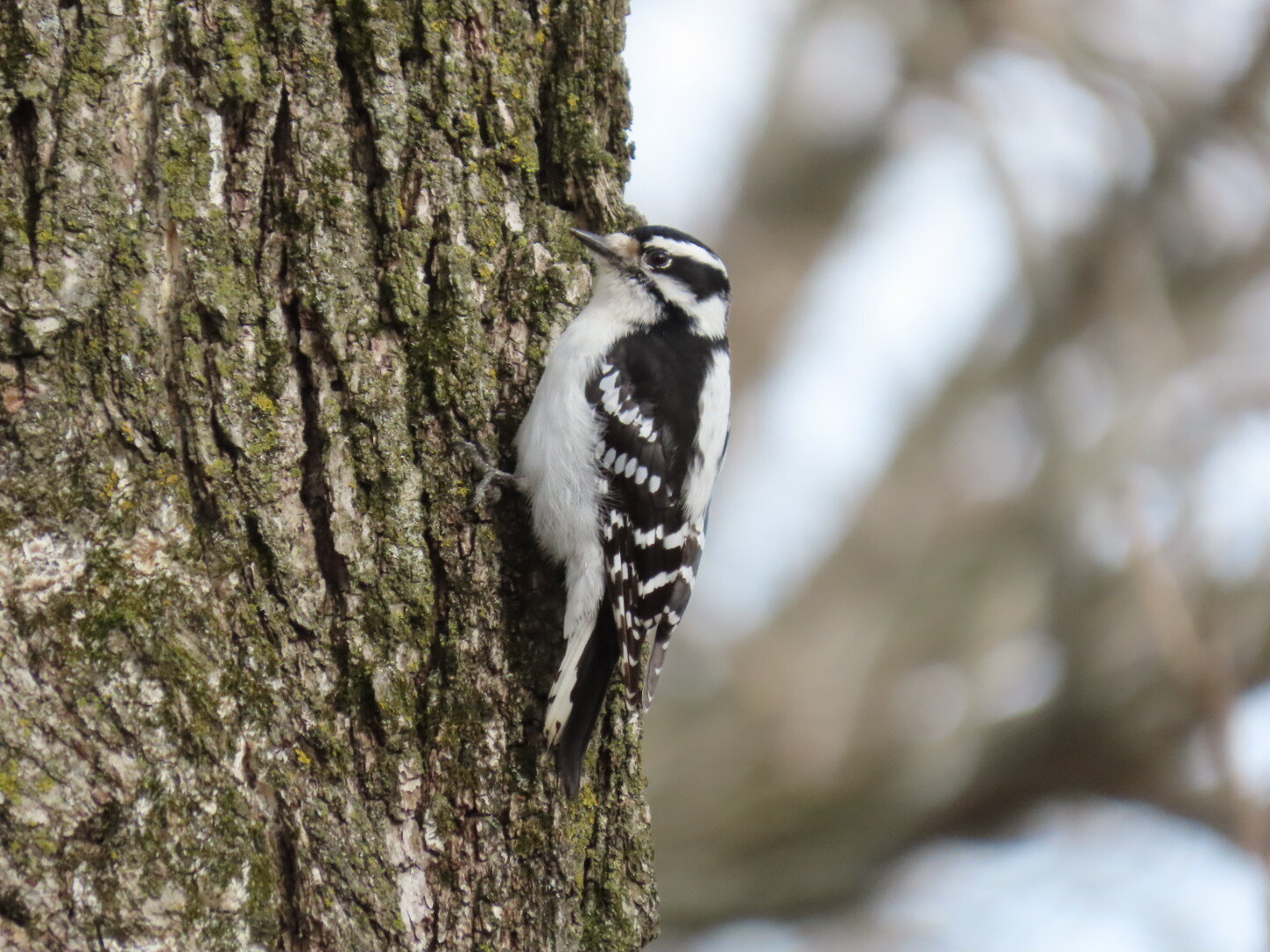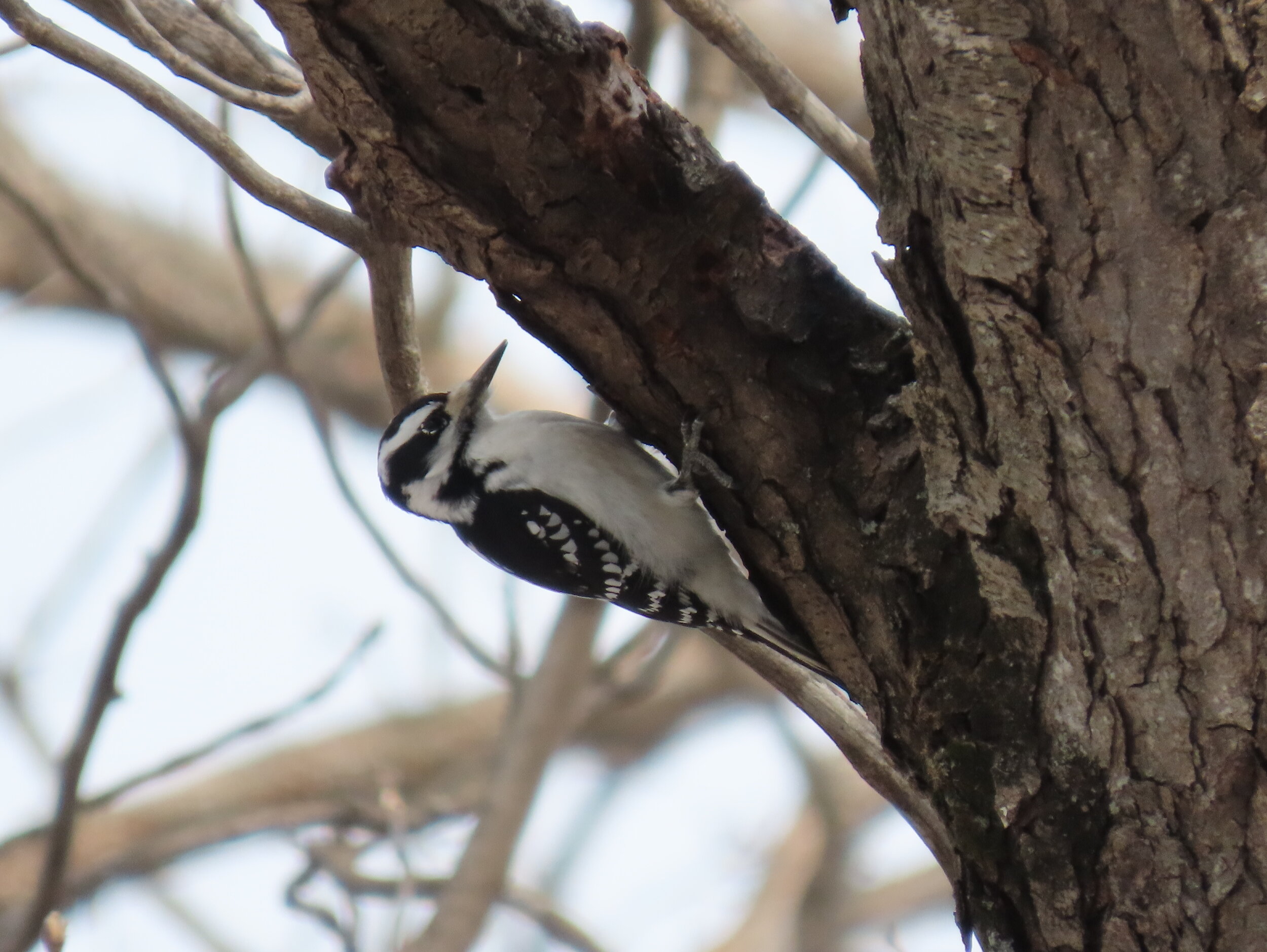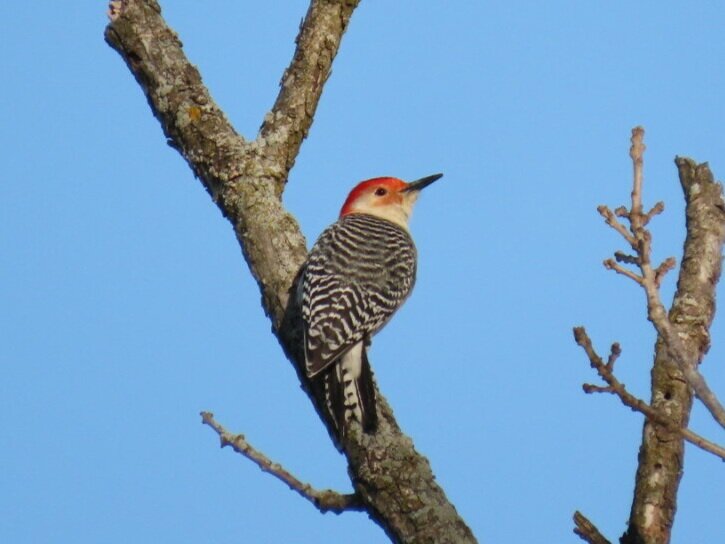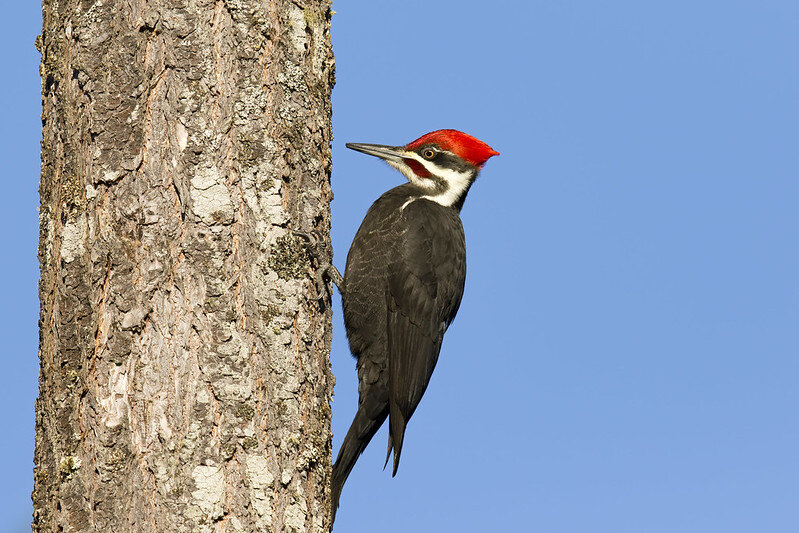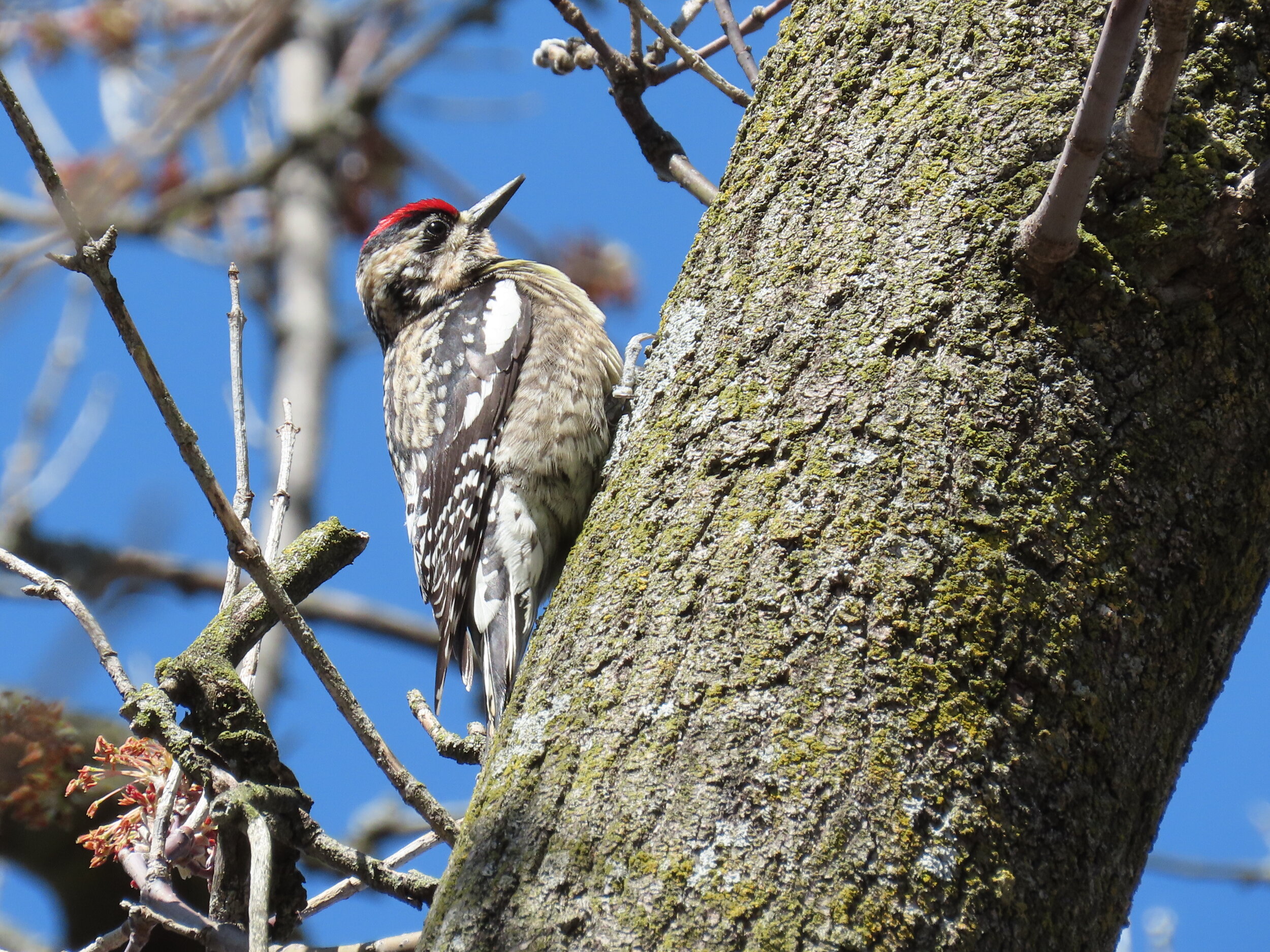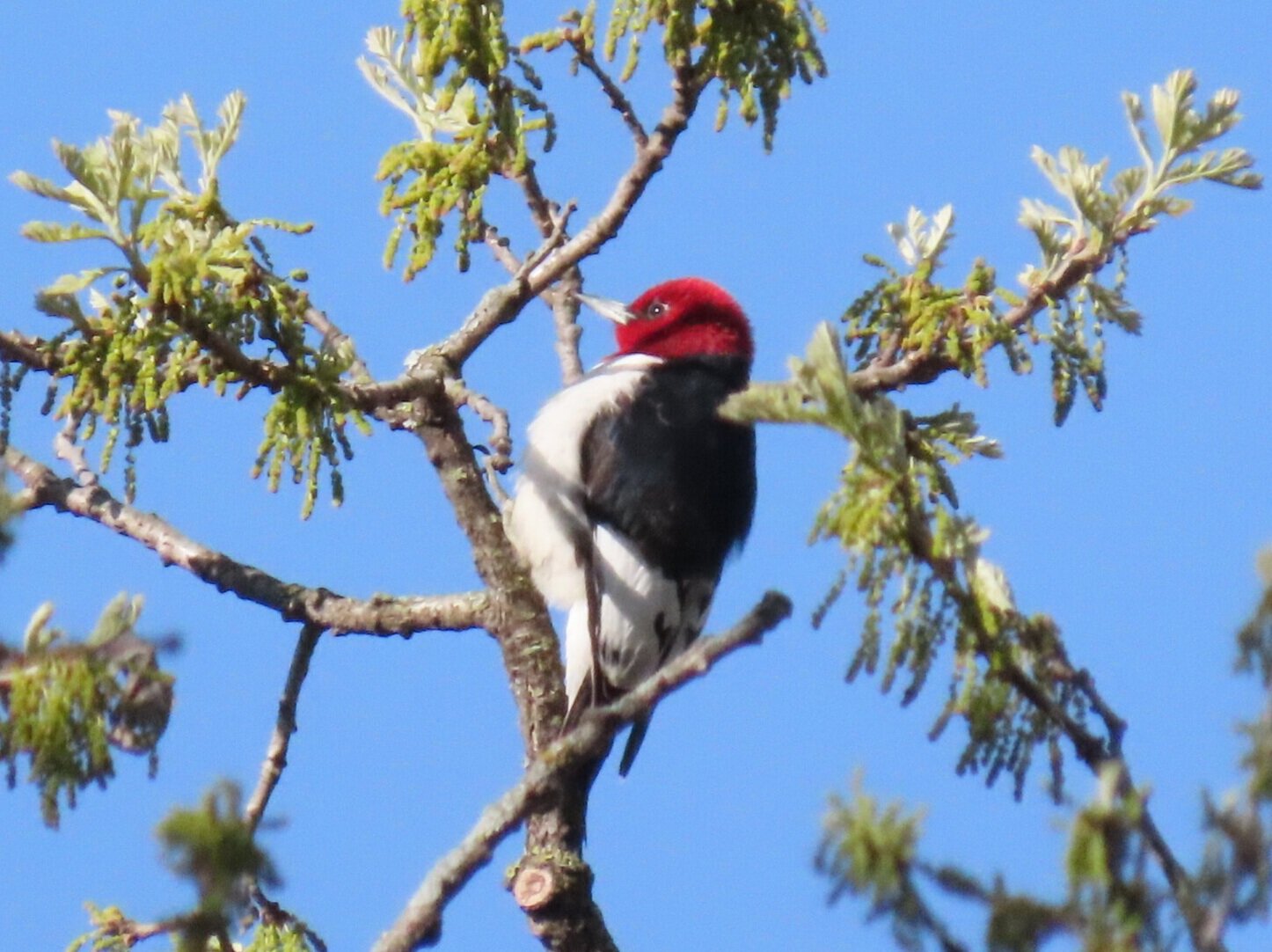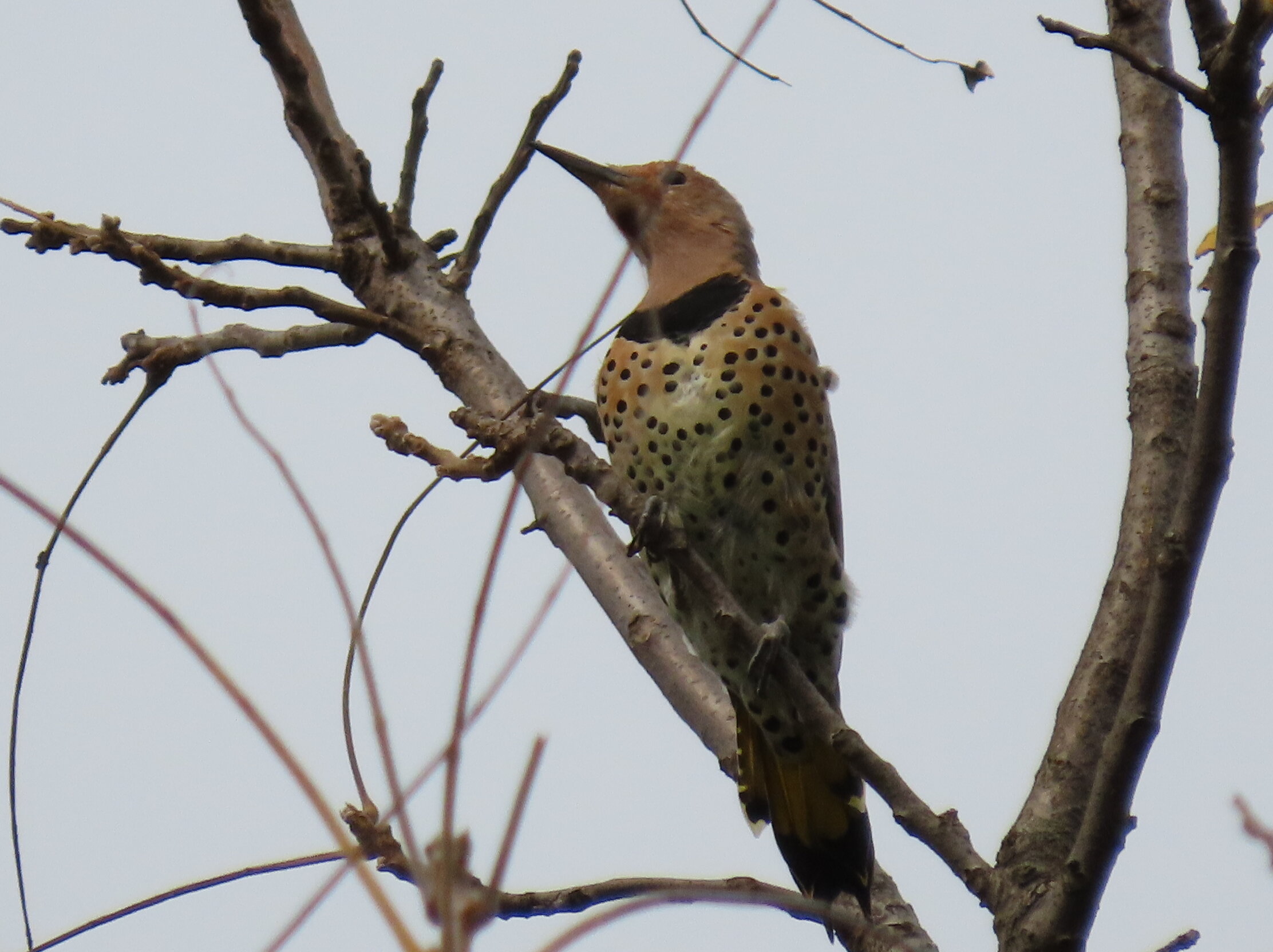Welcome back to the Entryway to Birding blog! It's only been a week since our last entry, but the bird world changes fast. New arrivals like sandhill cranes and red-winged blackbirds are making sure that if we hadn't yet seen that spring is here, that we'd at least hear it. Their songs and calls sure do signal a change of season.
The sounds of spring are again inspiration for this week's blog post. My last few birding sessions have featured lots of frenzied behavior from woodpeckers and nuthatches—species that are high into courtship right now. Early spring is a great time to do some slow birding and notice how the activity around you is shifting—you can witness some exciting behaviors and feel even more connected to the shifting of the seasons.
Woodpeckers may not sing like our vocal black-capped chickadees or northern cardinals, but they sure do drum. This week's Entryway to Birding blog takes us into the world of woodpeckers to decipher that drumming.
Are you seeing double too? I felt lucky to capture a shot of both of these red-bellied woodpeckers as they both tapped away on this tree—almost in unison! The woodpecker nearest the tree cavity had been poking around inside a few moments prior. Watching these two, I started to suspect that they may be scoping out a potential nest site. Photo by Caitlyn Schuchhardt
The Sounds of Spring Returning
Before we jump right into woodpeckers, I do want to take a quick moment to highlight just how much things have changed in the past week. If you're a new birder experiencing spring migration from the first time, get excited! March brings some of our earliest spring migrants and it can be a real joy to watch them trickle in, all while knowing that south of us there are even more birds on their journey northwards.
Our notable arrivals this week were sandhill cranes, red-winged blackbirds, killdeer, greater-white fronted geese, and lots and lots of duck species. Tundra swans (and a few trumpeter swans!) are coming back in large numbers, and a visit to spots with open water will not disappoint. I recommend the Lower Yahara River Trail—there is only open water along the stretch that connects Lake Waubesa to Upper Mud Lake right now, but that spot is hoppin' and many of the ducks are close to the trail, offering great views for those of you without binoculars or a scope.
The Lower Yahara River Trail offers a lot of fun waterfowl viewing opportunities. I don’t have a picture that represents that how bustlin’ the water can be near here, but trust me! This is a good spot to explore this week. Over the weekend, there was a lot of variety in the waterfowl close to the bridge—like hooded mergansers, common mergansers, common goldeneye, buffleheads, and tundra swans. An exciting and uncommon white-winged scoter has also been hanging at this spot for the past few days! Photo by Caitlyn Schuchhardt
This is the time of year where every day feels a bit different—a new arrival and perhaps a new departure. But for now, revel in this brief period where you can enjoy your favorite winter visitors (like those dark-eyed juncos) and your favorite spring arrivals (like those sandhill cranes) all in the same day.
Bird Behavior
In last week's post about birding without binoculars, we talked about how going birding without binoculars can encourage you to focus less on what the bird looks like and more on what it is doing and how it is exploring its habitat. You might find yourself more aware of the noises and vocalizations it may be making in the process.
I wasn’t able to photograph those fast-moving downy woodpeckers I was studying, but they danced around the tree trunk a lot, like these two males seem to be doing too! Photo by Dennis Church
Spring is really fun time to study woodpeckers and give them some of your slow birding attention—if they linger around and let you, that is! They are a great species to focus on if you're a beginning birder, because you can find them in so many places—including your urban parks and backyards.
On a recent walk at Cherokee North, I saw two downy woodpeckers—both males—caught up in what I can only assume was a territorial dispute. They were zipping around, doing what almost felt like a dance as they postured back and forth, before chasing each other around to different trees.
This went on for several minutes and allowed me the opportunity to pick out some unique features of their display tactics. Here's what went through my mind as I watched them:
First I tried to figure out if this was a territorial display or an impressively elaborate courtship dance. I was able to see that both downy woodpeckers had bright red patches on the back of their heads, which told me they were male and that this was probably about territory. Female downy woodpeckers will lack that red patch.
I noticed that both downy woodpeckers were putting their bodies into a weird position as they moved along the branches—both were raising their bills up and high into the air, almost as if they were trying to puff out their chest. This makes sense, as it's common for birds to try and make themselves appear larger to deter threats. I also noticed that they were both fanning their tails too—again another action that could make these tiny little woodpeckers seem bigger and more intimidating.
Their activity was frenetic—there were only a few times when they stopped moving and stared each other down! Otherwise they were zig-zagging among nearby trees, flicking their wings and making quite a commotion of what I can only describe as "squeaky" noises.
I couldn’t get any photos of those downies I was watching, but the one posed here reminded me of some of their "posturing” — notice how the crest is raised, the bill and head is pointed upwards so the chest sticks out, and the tail is fanned flat against the branch. When they downies I saw would stop and stare each other down, this is similar to the pose they would strike! Photo by Greg Schechter
Downy woodpeckers aren't the only woodpecker I've seen perform these territorial displays. A few weeks ago, I saw a pair of hairy woodpeckers similarly chasing each other around. Each species may have their own version of what they think makes them seem intimidating, but territorial behavior is common across woodpeckers. Reading up on this activity has confirmed that most of the "threat displays" of woodpeckers rely on such motions like bill pointing, crest-raising, wing flicking, tail fanning, and head shaking—anything to seem larger and more intimidating!
Keep an eye out for such commotion the next time you're in the woods, the park, or even your yard. And while you're at it, keep an ear out for more than just the standard calls of our woodpecker species … because now is the time for drumming!
for a Woodpecker, To Sing is to Drum
Woodpeckers are cavity nesters, so they will drill holes into trees and excavate cavities where they can lay their eggs. Sometimes they’ll use natural cavities or those made by other species, too. Here is a red-headed woodpecker poking out for what I assume is its nest, taken last summer. Photo by Caitlyn Schuchhardt
Woodpeckers spend a lot of time pecking at wood—unsurprisingly. You hear them do this all year long. They may be tapping at the bark as they search for food in the crevices, they may be drilling a small hole to get to those tasty bugs inside, or, later in spring, they may be carefully excavating a larger cavity to use for nesting.
In the field, that tap-tap-tap of their meticulous work sometimes gets referred to as drumming—as in "Oh, I can hear a woodpecker drumming over there" when you hear their persistent pecking as they work a tree. It's an easy descriptive word to use in the moment, but for new birders it can obscure the fact that drumming is a very specific type of noise that woodpeckers make during mating season. It's their version of a song!
I'll be honest, this confused me for an embarrassingly long time. On bird identification apps like Merlin Bird ID, which includes songs and calls for each species, I noticed that woodpecker species will have many examples of their calls, but also a sound entry for their drum. I'd listen to these but never really notice hearing anything like that in the field. That's because I wasn't listening at the right time, in the right season.
Drumming for woodpeckers is like the spring songs that our songbirds belt out to attract a mate—they happen during mating season but you're not likely to hear them throughout the rest of the year. But right now—as temperatures are getting warmer and days are getting longer—that shift into mating season is here and drumming season is just starting.
The goal of drumming is to establish a territory or attract a mate, so woodpeckers want to send their message far and wide. They will seek out trees or snags (or even sometimes metal objects!) that will allow their message to carry—the more hollow a tree, the better. You might notice the sound of drumming echoing throughout the woods, but don't let the loudness fool you—if a downy is drumming on a hollow snag, it can sound louder than you'd expect.
With patience and practice, some birders are able to ID woodpeckers based on the pattern or rhythm of their drum. This is a bit beyond my skillset yet—not gonna lie! But it is something that I have been deliberately paying more attention to as spring arrives. In the next section, we'll listen to some drumming of our region's woodpeckers so you can be familiar with what sets it apart from the regular tap-tap-tapping you may be familiar with.
The Who's Who of Wisconsin's Woodpeckers
There are several species of woodpecker you can find in south-central Wisconsin, though not all of them will be year-round residents. I'm going to give a quick overview of which woodpeckers you may be finding this season, and I'll break them into two groups—our non-migratory residents, who you can find year-round, and our migratory residents, who usually migrate south for the winter. (I say usually because it's not uncommon for a few to winter over, depending on the species.) You might hear any or all of these species drumming away this spring!
I’ve included some xeno-canto recordings of their drumming patterns. These are recordings made by everyday birders who submit them to xeno-canto for public use, so you can expect to hear other bird sounds in the background. Because the sound of drumming can vary so much based on what material the woodpecker is drumming on, pay less attention to the loudness and more attention to the rhythm.
Let's give a drumroll for our woodpecker line-up!
Wisconsin's non-migratory woodpeckers — find these four species year-round
Downy, hairy, and red-bellied woodpecker photos by Caitlyn Schuchhardt / Pileated woodpecker by Mick Thompson
Downy woodpecker. Our smallest woodpecker, the little downy has a very short bill and looks like a smaller version of the hairy woodpecker. You can find them tapping delicately at trees and may notice how the sounds of their tapping is often softer and more subtle than that of a hairy or red-bellied woodpecker. Their drumming, though, is sharp, rapid, and steady. It is quick and lasts just under a second but they will likely repeat it.
Hairy woodpecker. The longer bill and larger size of a hairy woodpecker can set it apart from it's close look-alike, the downy. Their drums may seem similar at first too, but you'll notice that the hairy woodpeckers drumming is "sized up" from the downy's drum, just like everything else about this species. The pace is faster and more rapid and it lasts slightly longer. If you were to slow down and count the individual "taps" in the drumming, you'd find about 26 notes in the hairy woodpeckers drum—but they go by so rapidly you can barely pick them out! A downy's, by comparison, is only going to have about half as many notes, 13 on average.
Red-bellied woodpecker. Red bellied woodpeckers will use a combination of calls and drumming to communicate with their potential mates, so listen for both their kwirr, kwirr calls and their drumming. I've also read that "mutual tapping" (perhaps what I was seeing above in our cover photo!) is an important part of pair bonding, so look out for that too. Their drumming is a bit harder to distinguish and I know I'd struggle to ID it in the field alone. It has a deeper, less sharp quality than the downy, but is still fast and steady.
Pileated woodpecker. Our largest woodpecker, a pileated is always an exciting find! And because this bird is so much larger and is powerful in its ability to tap and drum, you might hear the noise of a pileated without ever spotting one—it may echo across the woods! With a careful eye, too, you might notice signs of a pileated woodpecker's activity—they can leave behind a lot of woodchips if they are doing some hardcore excavation. Their drumming is more distinct than the three woodpeckers above—it is deep, slow, and rolling, and it peters off near the end.
This here is a sign there may be a pileated nearby! Look at all those woodchips at the base of this heavily-hammered-at tree! Photo by Caitlyn Schuchhardt
Wisconsin's migratory woodpeckers — they return in the spring and leave around winter
Photos by Caitlyn Schuchhardt
Yellow-bellied sapsucker. Yellow-bellied sapsuckers are a fascinating woodpecker. Where other woodpeckers will peck away searching for bugs, the sapsucker will drill careful holes into the tree and let the sap flow. It will feed on the sap but also on the many bugs that will get trapped in it! Their sapwells are useful for other birds too, like hummingbirds who drink the sap and warblers looking for insects. Their drumming is my favorite, perhaps because it too is unique among the other woodpecker species. It's a slow, deliberate, yet irregular rhythm that sounds like someone is tapping out morse code.
Red-headed woodpecker. Red-headed woodpeckers aren't as commonly seen as other woodpecker in our area, but they do reside here! They may not always overwinter, but sometimes they will if they have a good supply of food like acorns. They enjoy habitat with lots of dead trees and snags where they can build their nests. Their drum is a tough one to distinguish—it is fast, rapid, and steady like the downy's above, often given in sets of two. Listen here.
Northern flicker. In a woodpecker world of what feels like black, white, and red, northern flickers stand out. They're a bit unique for other reasons too—mostly because they spend more time on the ground than their fellow woodpeckers! Flickers are notorious for their love of ants and many ants live on the ground, thus flickers head there too. Their drumming is again one of those less distinct drums, long and steady with many rapid notes—often around 20+ notes over the span of a second, like the hairy woodpecker's.
With the exception of the yellow-bellied sapsucker, I cannot identify a woodpecker by drumming alone without having another auditory or visual cue to help me out. And to be honest, I'm not really interested in being able to do that with complete success either—I’ve got enough bird songs and calls to worry about this spring! But I do find it worthwhile to slow down, to listen intently, to really take in the behavior and vocalizations of these species—especially at the changing of the seasons, when there is a lot of new bird behaviors happening that can teach you more and more about the birds we see so often.
If you're a new birder, taking the time to study the movements and behavior of woodpeckers is something that will reward you not just in spring, but year-round. Since so many of them are residents and likely to be found in each season, learning them—and their behavioral quirks—can help you in the long run.
My challenge for you all this week is to see if you can hear a woodpecker—any woodpecker—start up its drumming! I've heard a few instances of it just in the last few days, but drumming is something you'll want to have on your radar as we continue into March and April.
That's all for this week! Happy birding!
A pileated woodpecker perches below an eave. If their drumming seems loud in the woods, I imagine it is even louder on one’s house! Photo by The Real Kam75
P.S. When I was doing some research on woodpecker drumming, the vast majority of the posts that I ran across were not about learning more about drumming behavior, but rather deterring woodpeckers from drumming on houses. As a non-homeowner who did not have this on my radar, I wasn't expecting that to be 99% of my search results! Massachusetts Audubon has a great page to help you learn more about woodpecker drumming behavior and how it relates to your home, plus some safe and effective deterrents to keep them from damaging your siding, if you find yourself in the position of needing that information.
_____
Caitlyn is a volunteer with Madison Audubon. She’s crazy for birds because they changed her life! She’ll be back next Monday with some tips and tools for birders, new and experienced! Between now and then, she’d love to hear from you. What birds are you seeing or hearing? How is birding changing your world? What birding content would you like to see next? Leave a comment below!







